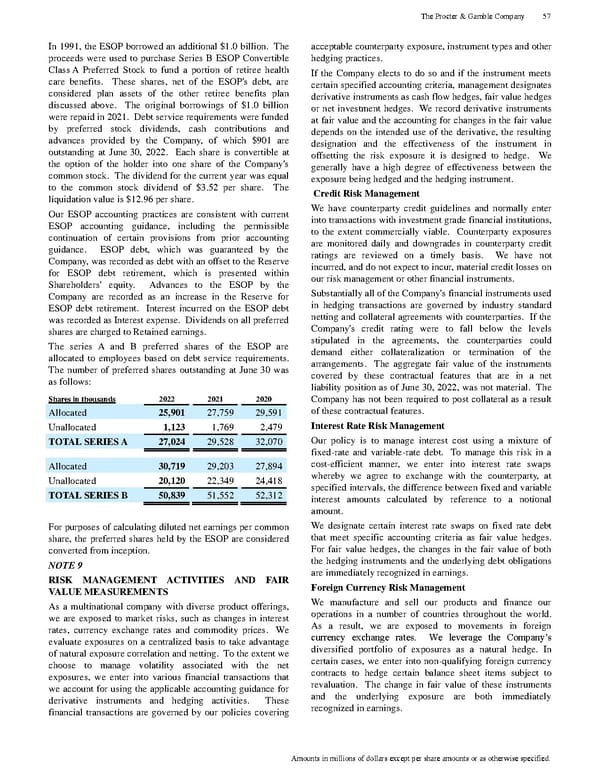In 1991, the ESOP borrowed an additional $1 .0 billion. The proceeds were used to purchase Series B ESOP Convertible Class A Preferred Stock to fund a portion of retiree health care benefits. These shares, net of the ESOP's debt, are considered plan assets of the other retiree benefits plan discus sed above. The original borrowings of $1.0 billion were repaid in 2021. Debt service requirements were funded by preferred stock dividends, cash contributions and advances provided by the Company, of which $901 are outstanding at June 30, 2022. Each sha re is convertible at the option of the holder into one share of the Company's common stock. The dividend for the current year was equal to the common stock dividend of $3.52 per share. The liquidation value is $12.96 per share. Our ESOP accounting practices are consistent with current ESOP accounting guidance, including the permissible continuation of certain provisions from prior accounting guidance. ESOP debt, which was guaranteed by the Company, was recorded as debt with an offset to the Reserve for ESOP debt retirement, which is presented within Shareholders' equity. Advances to the ESOP by the Company are recorded as an increase in the Reserve for ESOP debt retirement. Interest incurred on the ESOP debt was recorded as Interest exp ense. Dividends on all preferred shares are charged to Retained earnings. The series A and B preferred shares of the ESOP are allocated to employees based on debt service requirements. The number of preferred shares outstanding at June 30 was as follows: Shares in thousands 2022 2021 2020 Allocated 25,901 27,759 29,591 Unallocated 1,123 1,769 2,479 TOTAL SERIES A 27,024 29,528 32,070 Allocated 30,719 29,203 27,894 Unallocated 20,120 22,349 24,418 TOTAL SERIES B 50,839 51,552 52,312 For purposes of calculating diluted net earnings per common share, the preferred shares held by the ESOP are considered converted from inception. NOTE 9 RISK MANAGEMENT ACTIVITIES AND FAIR VALUE MEASUREMENTS As a multinational company wit h diverse product offerings, we are exposed to market risks, such as changes in interest rates, currency exchange rates and commodity prices. We evaluate exposures on a centralized basis to take advantage of natural exposure correlation and netting. To t he extent we choose to manage volatility associated with the net exposures, we enter into various financial transactions that we account for using the applicable accounting guidance for derivative instruments and hedging activities. These financial transa ctions are governed by our policies covering acceptable counterparty exposure, instrument types and other hedging practices. If the Company elects to do so and if the instrument meets certain specified accounting criteria, management designates derivative instruments as cash flow hedges, fair value hedges or net investment hedges. We record derivative instruments at fair value and the accounting for changes in the fair value depends on the intended use of the derivative, the resulting designation and the e ffectiveness of the instrument in offsetting the risk exposure it is designed to hedge. We generally have a high degree of effectiveness between the exposure being hedged and the hedging instrument. Credit Risk Management We have counterparty credit guid elines and normally enter into transactions with investment grade financial institutions, to the extent commercially viable. Counterparty exposures are monitored daily and downgrades in counterparty credit ratings are reviewed on a timely basis. We have not incurred, and do not expect to incur, material credit losses on our risk management or other financial instruments. Substantially all of the Company's financial instruments used in hedging transactions are governed by industry standard netting and collateral agreements with counterparties. If the Company's credit rating were to fall below the levels stipulated in the agreements, the counterparties could demand either collateralization or termination of the arrangements. The aggregate fair value of the instruments covered by these contractual features that are in a net liability position as of June 30, 2022, was not material. The Company has not been required to post collateral as a result of these contractual features. Interest Rate Risk Managemen t Our policy is to manage interest cost using a mixture of fixed - rate and variable - rate debt. To manage this risk in a cost - efficient manner, we enter into interest rate swaps whereby we agree to exchange with the counterparty, at specified intervals, the difference between fixed and variable interest amounts calculated by reference to a notional amount. We designate certain interest rate swaps on fixed rate debt that meet specific accounting criteria as fair value hedges. For fair value hed ges, the changes in the fair value of both the hedging instruments and the underlying debt obligations are immediately recognized in earnings. Foreign Currency Risk Management We manufacture and sell our products and finance our operations in a number of countries throughout the world. As a result, we are exposed to movements in foreign currency exchange rates. We leverage the Company’s diversified portfolio of exposures as a natural hedge. In certain cases, we enter into non - qualifying foreign currency contracts to hedge certain balance sheet items subject to revaluation. The change in fair value of these instruments and the underlying exposure are both immediately recognized in earnings. The Procter & Gamble Company 57 Amounts in millions of dollars except per share amounts or as otherwise specified.
 The Procter & Gamble Annual Report Page 68 Page 70
The Procter & Gamble Annual Report Page 68 Page 70